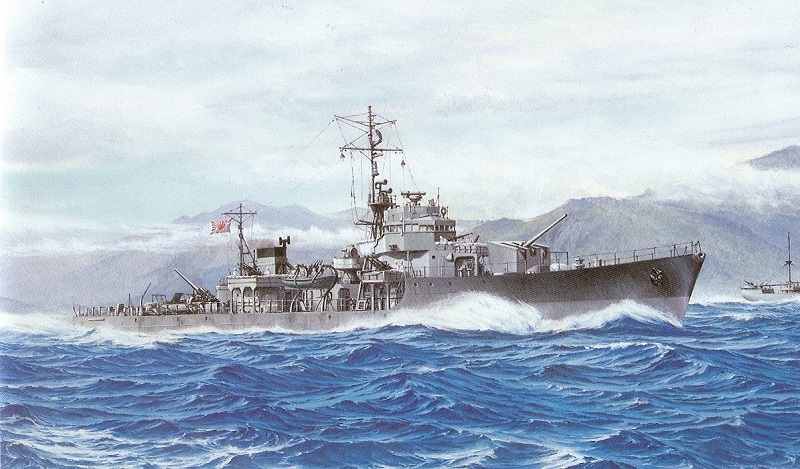© 2006-2015 Bob Hackett, Sander Kingsepp and Peter Cundall
Revision 1
15 May 1944:
Tamano. Laid down at Mitsui Engineering & Shipbuilding’s yard.
25 September 1944:
Launched and named INAGI.
26 December 1944:
Completed and registered in the Kure Naval District. Attached to the Kure Guard Unit. Reserve Cdr Yamada Chuuta is the Commanding Officer.
26 January 1945:
Assigned to the General Escort Command’s First Escort Fleet.
29 January 1945:
At 0700 INAGI and CD-81 departs Kure. At 1530 the escorts arrive at Moji.
31 January 1945:
INAGI departs Moji for Singapore with kaibokan CD-66 and CD-83 escorting convoy HI-95 consisting of Type 2TL tankers AMATO and FUJISAN MARUs.
1 February 1945:
At 0100, arrives at Reisui Harbor, South Korea. Departs at 0700 that day.
6 February 1945:
At 1600 anchors at Lao Man Shan. Departs later that day.
7 February 1945:
At 0800, arrives and anchors at Yalang Bay, Hainan Island.
8 February 1945:
At 1700, departs Yalang Bay.
9 February 1945:
At 1700, arrives at Quinhon Bay, Indochina.
10 February 1945:
At 0730, departs Quinhon Bay. At 1720 arrives at Camranh Bay.
11 February 1945:
At 0730 departs Camranh Bay.
14 February 1945:
At 2002 arrives at Singapore.
22 February 1945:
At 1800 INAGI departs Singapore for Moji with kaibokan CD-66 and CD-81 escorting convoy HI-96 consisting of AMATO, MITSUSHIMA and FUJISAN MARUs.
27 February 1945:
Off Camranh Bay, Indochina. At 0035, LtCdr (later Cdr) William H. Hazzard’s (USNA ’35) USS BLENNY (SS-324) torpedoes and sinks tanker AMATO MARU at 11-56N, 109-18E. 73 crewmen and 76 passengers are KIA.
28 February 1945:
Near Hainan Island. At 2025, a B-29 is spotted and air raid preparations are made by the convoy.
1 March 1945:
Hainan Strait. At 1430, an air attack by B-24 “Liberator” heavy bombers begins. On the third attack, at 1540, MITSUSHIMA MARU is damaged and forced to jettison 2,500 tons of crude. She is detached for repairs at Hong Kong escorted by CD-66. FUJISAN MARU escapes the attacks with only minor damage from near misses. She heads for Moji escorted by INAGI and CD-81. They stop at various anchorages up the Chinese coast. At 2100 arrives at Howshui Wan.
3 March 1945:
At 0800 departs Howshui Wan. At 2000 arrives at Tien Pai Wan.
5 March 1945:
Departs Tien Pai Wan. At 2300 arrives off north coast of Wan Shan Island, Ladrone Islands.
6 March 1945:
At 0700 departs Wan Shan escorting FUJISAN MARU with CD-81.
7 March 1945:
At 2000 arrives at Amoy.
8 March 1945:
At 0630 departs Amoy.
10 March 1945:
Arrives at Ssu Chiao Shan (Shushan Island) at 1000. Prior to this kaibokan AGUNI had joined as an additional escort.
11 March 1945:
Departs Ssu Chiao Shan (Shushan Island) at 0900. At 2000 arrives at Sinjin Do (Shinchi Do), Chosen.
12 March 1945:
At 0600 departs Sinjin Do and at 1800 arrives at Katoku Suido.
13 March 1945:
At 0500 departs Katoku Suido. At 1810, arrives at Moji.
14 March 1945:
At 0600 departs Moji.
15 March 1945:
Arrives at Kure. Undergoes repairs.
31 March 1945:
Off Hesaki. Six USAAF B-29 “Super Fortresses” mine the waters off Kure. INAGI hits one and is damaged.
April 1945:
Arrives at Kure. Undergoes repairs.
25 April 1945:
Reassigned to the General Escort Command's First Escort Fleet's 12th Escort Group.
28 April 1945:
At 0600, INAGI departs Moji for Shanghai with kaibokan OJIKA and CD-59 escorting convoy MOSHI-05 consisting of MIHO MARU. At 2000, that same day, the convoy arrives at Chinkai, South Korea.
29 April 1945:
At 0500, departs Chinkai.
30 April 1945:
At 1408, Cdr Allen R. Faust’s (USNA ’36) USS TREPANG (SS-412) torpedoes and sinks MIHO MARU with 153 passengers, weapons, ammunition, war supplies and Daihatsu barges. 14 crewmen, 26 guards, and 94 passengers are KIA. The kaibokan counter-attack and drop 27 depth charges, but USS TREPANG escapes undamaged. The escorts head towards Shanghai.
2 May 1945:
LtCdr Russell Kefauver’s (USNA ’33) USS SPRINGER (SS-414) attacks the escorts and fires a spread of four torpedoes. SPRINGER's crew hears the first explode and then see and hears two more hits which sinks kaibokan OJIKA with all 226 crewmen.
25 June 1945:
Departs Maizuru.
26 July 1945:
Departs Ominato.
9 August 1945:
Onagawa Bay, NE Honshu. INAGI, kaibokan AMAKUSA, supply ship SOYA, minesweeper W-33, target ship OHAMA and subchaser CH-42 are at anchor when they are attacked by F-4U Mark IV "Corsair" fighter-bombers of Vice Admiral (later Admiral) Sir Bernard J. Rawlings, RN, Task Force 37’s (British Pacific Fleet) carrier HMS FORMIDABLE.
INAGI takes a direct bomb hit to her aft deck that wrecks the engine room. She takes on a steep list to starboard and sinks that evening. AMAKUSA (seventy-one sailors, including all members of her "black gang" KIA) and OHAMA (unknown casualties) are also sunk 38-26N, 141-30E. Twenty-nine crewmen are KIA and 35 seriously wounded on INAGI.
During the attack, Lt Robert H. Gray, RCNVR, lead pilot of HMS FORMIDABLE’s 1841st Squadron flight of Corsairs, sinks his target, a "destroyer", but is brought down by heavy AA fire and crashes flames. Gray is posthumously awarded the Victoria Cross, the fourth and last Commonwealth naval airman to be so honored.
Nagasaki. That same day, the CO of the 393rd Bomb Squadron of the 509th Composite Group, Major (later Brig Gen, ANG) Charles W. Sweeney, piloting a B-29 nicknamed "BOCKSCAR", drops "Fat Man", the second atomic bomb. Japan agrees to an end of hostilities within a week.
15 September 1945:
Removed from the Navy List.
August - 30 November 1947:
Scrapped.
Authors' Note:
Thanks for assistance go to Dr. Higuchi Tatsuhiro of Japan and to Mr. Gilbert Casse of France. Thanks also go to Jeff Donahoo of Iowa for help in identifying kaibokan COs.
-Bob Hackett, Sander Kingsepp and Peter Cundall
Back to
Escort Page



